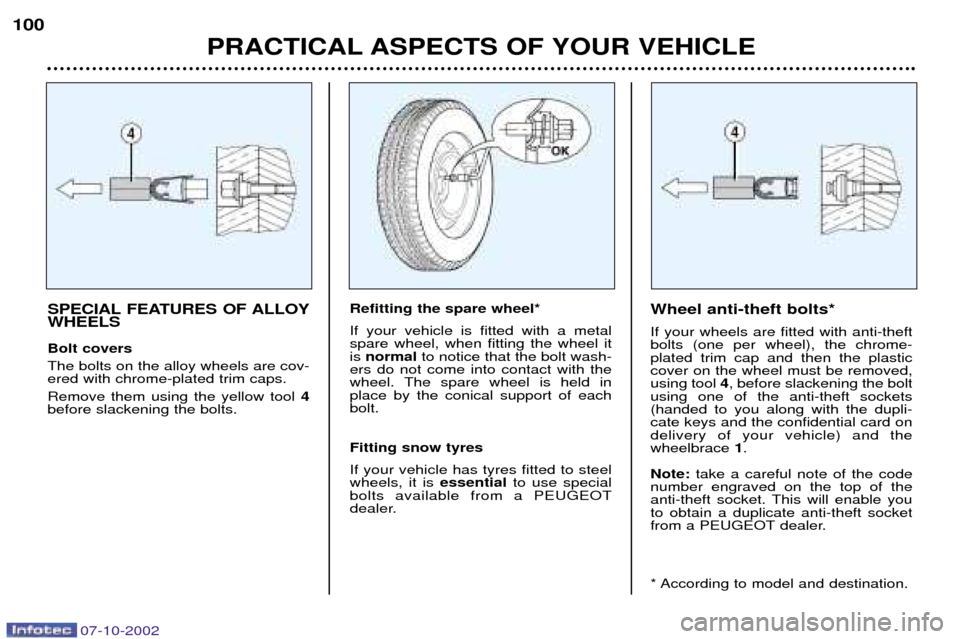Page 92 of 124

YOUR 206 CC IN DETAIL
92
For the front and side air bags to be fully effective, observe the following safety rules:
¥ Wear a correctly adjusted seat belt.
¥ Sit in a normal upright position (passengers must not place their feet on the fascia).
¥ Ensure there is nothing between the occupants of the front seats and the air bags. This could hamper the operation of the air bags or injure the occupants.
¥ All work on the air bag systems is strictly forbidden unless it is carried out by qualified personnel of the PEUGEOT network.
¥ After an accident or if the vehicle has been stolen or broken into, have the air bag systems checked.
¥ The air bag systems have been designed to be fully operational for 10 years after the vehicle has been registered. For greater safety, have them checked by a PEUGEOT dealer within ten years following the initial purchase of the vehicle.
Front air bags
¥ Do not drive holding the steering wheel by its spokes or resting your hands on the centre part of the wheel.
¥ Never remove or pierce the steering wheel or hit it violently.
¥ Smoke as little as possible; deployment of the air bags can cause burns or the risk of injury from a cigarette or pipe. Side air bags
¥ Do not fix or glue anything to the front seat backs. This could cause injury to the chest or arms when the side air bag inflates.
¥ Do not sit with the upper part of the body any nearer to the door than necessary.
¥ Use only approved covers on the front seats. Contact your PEUGEOT dealer.
07-10-2002
Page 94 of 124

YOUR 206 CC IN DETAIL
92
For the front and side air bags to be fully effective, observe the following safety rules:
¥ Wear a correctly adjusted seat belt.
¥ Sit in a normal upright position (passengers must not place their feet on the fascia).
¥ Ensure there is nothing between the occupants of the front seats and the air bags. This could hamper the operation of the air bags or injure the occupants.
¥ All work on the air bag systems is strictly forbidden unless it is carried out by qualified personnel of the PEUGEOT network.
¥ After an accident or if the vehicle has been stolen or broken into, have the air bag systems checked.
¥ The air bag systems have been designed to be fully operational for 10 years after the vehicle has been registered. For greater safety, have them checked by a PEUGEOT dealer within ten years following the initial purchase of the vehicle.
Front air bags
¥ Do not drive holding the steering wheel by its spokes or resting your hands on the centre part of the wheel.
¥ Never remove or pierce the steering wheel or hit it violently.
¥ Smoke as little as possible; deployment of the air bags can cause burns or the risk of injury from a cigarette or pipe. Side air bags
¥ Do not fix or glue anything to the front seat backs. This could cause injury to the chest or arms when the side air bag inflates.
¥ Do not sit with the upper part of the body any nearer to the door than necessary.
¥ Use only approved covers on the front seats. Contact your PEUGEOT dealer.
07-10-2002
Page 99 of 124

PRACTICAL ASPECTS OF YOUR VEHICLE97
PUNCTURES Because this version does not pos- sess a spare wheel, you have twoaerosols for temporary tyre repairsstored in an insulated storage box
1
secured by a strap to the right-handside of the boot. Using a repair aerosol (See also the instructions on the aerosols). �
If possible remove the foreign body which caused the puncture.
� Position the wheel so that the valveis at the 2 o'clock or 10 o'clock posi-tion.
� Shake the aerosol vigorously
before use. (In very cold weather,warm the aerosol for a few minutesin your hands).
� In one hand hold the valve.
� With the other, firmly push thespray end of the aerosol onto thevalve, keeping it centralised.
� Maintain the pressure firmly for oneminute, then immediately drive at
moderate speed to the nearest
garage. Aersosols enable a tempo-rary repair to be carried out(maximum speed 50 mph(80 km/h)).
After use, it is necessary to repairthe tyre. Because the aerosols are pres- surised, they must not be exposed
to a temperature higher than 50 ¡C. Keep them away from heat in their insulated storage box.
07-10-2002
Page 100 of 124

PRACTICAL ASPECTS OF YOUR VEHICLE
98
CHANGING A WHEEL �
Park the vehicle on level, stable
ground which is not slippery.
� Apply the handbrake, engage first
gear or reverse (position Pon the
automatic gearbox) and switch offthe ignition.
� Chock the rear of the wheel withshim 2diagonally opposite the
wheel to be changed.
Tools for changing a wheel 1 - Wheelbrace fitted to the lining of the boot on the rear right side.
2 - Shim stored in the jack bag.
3 - Jack (in a bag secured by two straps,on the right-hand side of the boot).
4 - Tool for removing wheel bolt trims(located on the boot rear right innerpanel). Removing the wheel �
Remove the wheel trim using the wheelbrace 1by pulling next to the valve.
� Loosen the wheel bolts (for vehicles fitted with alloy wheels, remove the chrome wheel bolts first; see "Features of alloy wheels", following page).
� Position the jack 3at one of the four locations Aunderneath the vehicle, as
close as possible to the wheel to be changed. Ensure that the entire surface ofthe jack base plate is in contact with the ground.
� Extend the jack 3.
� Remove the bolts and release the wheel.
07-10-2002
Page 101 of 124
PRACTICAL ASPECTS OF YOUR VEHICLE99
Refitting the wheel �
After positioning the wheel, pre-tighten the bolts using the wheelbrace 1.
� Compress the jack 3and release it.
� Fully tighten the bolts using the wheelbrace 1.
� Replace the wheel trim, starting at the valve passage hole, and press on it using the palm of the hand.
Replace the shim and the jack in their bag, then store the tools in the boot.For your safety, always change the wheel:
Ð on level, stable and non- slippery ground,
Ð with the handbrake applied and the ignition switched off,
Ð with the first or reverse gear engaged (position Pfor the auto-
matic gearbox),
Ð with the vehicle chocked using a shim.
Never go underneath a vehicle which is supported only by a jack(use an axle stand) .
After changing the wheel:
Ð As soon as possible contact a PEUGEOT dealer to check that the wheel bolts are tight.
07-10-2002
Page 102 of 124

PRACTICAL ASPECTS OF YOUR VEHICLE
100
SPECIAL FEATURES OF ALLOY WHEELS Bolt covers The bolts on the alloy wheels are cov- ered with chrome-plated trim caps. Remove them using the yellow tool
4
before slackening the bolts. Refitting the spare wheel* If your vehicle is fitted with a metal spare wheel, when fitting the wheel itis
normal to notice that the bolt wash-
ers do not come into contact with the
wheel. The spare wheel is held inplace by the conical support of eachbolt. Fitting snow tyres If your vehicle has tyres fitted to steel wheels, it is essentialto use special
bolts available from a PEUGEOT
dealer. Wheel anti-theft bolts* If your wheels are fitted with anti-theft bolts (one per wheel), the chrome-plated trim cap and then the plasticcover on the wheel must be removed,using tool
4, before slackening the bolt
using one of the anti-theft sockets(handed to you along with the dupli-cate keys and the confidential card ondelivery of your vehicle) and thewheelbrace 1.
Note: take a careful note of the code
number engraved on the top of the
anti-theft socket. This will enable youto obtain a duplicate anti-theft socket
from a PEUGEOT dealer.
* According to model and destination.
07-10-2002
Page 105 of 124
07-10-2002
PRACTICAL INFORMATION103
Rear lights Release the top of the boot side trim. Unscrew the wing bolt inside the boot
using the wheelbrace if necessary. Disconnect the connector
A.
Release the light unit.Release spanner B from the bulb holder.
Unscrew nut Cusing spanner B and
removet the bulb holder. Change the faulty bulb.When refitting, stow spanner B on
support D and refit the light.
1. Amber direction indicators
PY 21 W.
2. Reversing lights P 21 W.
3. Brake lights/side lights P 21/5 W.Front fog lamps H1 55 W Press underneath the access flap to release it. Open the flap.
Turn the cover to remove it.Disconnect the bulb.Pinch both ends of the securing clip to release the bulb.
The "amber" bulbs must bereplaced by bulbs of identi-
cal specification and colour.
Page 109 of 124
07-10-2002
Fuse RatingFunctions
1 15 A Heated seat - Alarm
4 20 A Mulltifunction screen - Navigation control unit - Boot lighting - Audio system - Retractable roof control unit
5 15 A Automatic gearbox diagnostics
6 10 A Coolant level - Automatic gearbox - Audio system - Steering wheel angle sensor (ESP)
7 15 A Driving school accessories - Alarm fitted as an accessory - Rain detector
9 30 A Hydraulic pump
10 40 A Driving mirror demisting 11 15 A Windscreen wiper
12 30 A Front windows
14 10 A Engine module - Air bags - Steering wheel stalk
15 15 A Instrument panel - Multifunction screen - Navigation control unit - Air conditioning - Audio system
16 30 A Locking/unlocking of doors
20 10 A Right-hand brake light
21 15 A Left-hand brake light - 3rd brake light
22 30 A Front courtesy light - Glove box lighting - Lighter
S1 Shunt PARC shunt PRACTICAL INFORMATION
106